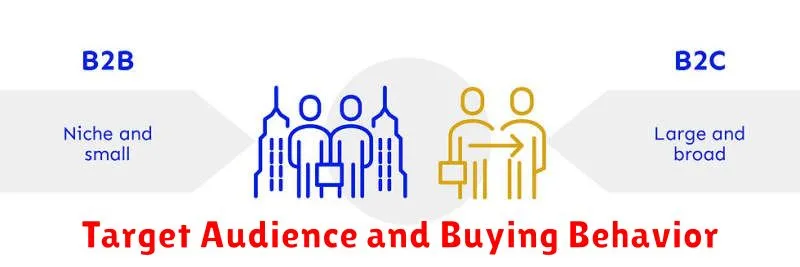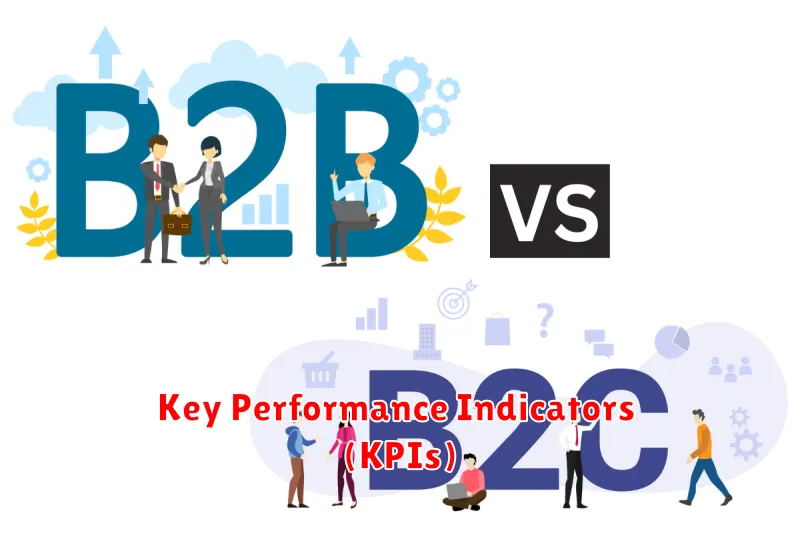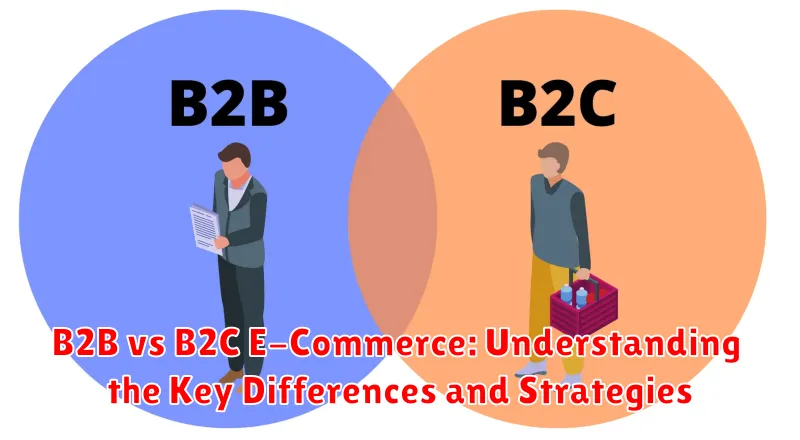Navigating the world of e-commerce requires a keen understanding of the distinct landscapes of Business-to-Business (B2B) and Business-to-Consumer (B2C) e-commerce. While both involve online transactions, their target audiences, sales cycles, marketing strategies, and overall approaches differ significantly. This article delves into the core distinctions between B2B and B2C e-commerce, providing valuable insights into the key characteristics that define each model. Understanding these fundamental differences is crucial for businesses seeking to establish a robust online presence and achieve sustainable growth in their respective markets.
Whether you’re a seasoned entrepreneur or just starting your e-commerce journey, grasping the nuances of B2B e-commerce versus B2C e-commerce is paramount for success. From sales cycles and marketing strategies to customer relationships and technology platforms, the approaches vary widely. This exploration will empower you to make informed decisions about your e-commerce strategy, regardless of whether your focus is on building relationships with other businesses in the B2B realm or connecting directly with consumers in the B2C sphere. By examining the core differences, you can tailor your approach to effectively reach your target audience and drive meaningful results.
Defining B2B and B2C E-Commerce
Business-to-business (B2B) e-commerce refers to online transactions between businesses. This typically involves companies selling products or services to other businesses, such as a wholesaler selling to a retailer, or a software company selling its platform to a corporation. B2B transactions often involve larger order volumes, longer-term contracts, and more complex pricing structures.
Business-to-consumer (B2C) e-commerce, on the other hand, involves businesses selling directly to individual consumers. This is the most common form of e-commerce and encompasses a wide range of products and services, from clothing and electronics to food delivery and online courses. B2C transactions are generally characterized by smaller order sizes, shorter sales cycles, and simpler pricing models.
The core distinction lies in the target customer: B2B caters to businesses with specific organizational needs, while B2C focuses on individual consumers and their personal requirements.
Target Audience and Buying Behavior

A core distinction between B2B and B2C e-commerce lies in the target audience and their respective buying behaviors. B2B targets businesses, organizations, and institutions. Purchasing decisions are often made by multiple stakeholders, involving a more complex and considered process. Buyers prioritize factors like return on investment (ROI), efficiency, and long-term value.
B2C, on the other hand, targets individual consumers. Buying decisions are typically driven by personal needs and wants, with a greater emphasis on emotional factors like brand affinity and social influence. The purchase process tends to be faster and less formal.
Understanding these fundamental differences is crucial for tailoring effective e-commerce strategies.
Sales Cycles and Order Values
A core distinction between B2B and B2C e-commerce lies in the length of the sales cycle and the typical order values. B2B sales cycles are often significantly longer than B2C. This is due to the complex nature of B2B transactions, which frequently involve multiple stakeholders, negotiations, and customized solutions. B2C sales, in contrast, are usually swift, driven by immediate consumer needs and simpler purchasing processes.
Order values also differ drastically. B2B transactions typically involve larger quantities and higher prices, resulting in substantially greater order values compared to B2C. B2C orders tend to be smaller, reflecting individual consumer needs and budgets. This difference impacts various aspects of e-commerce operations, from payment processing to logistics and customer service.
Marketing Strategies and Channels
B2B marketing often focuses on building relationships, establishing credibility, and demonstrating value. Common channels include content marketing (e.g., white papers, webinars), email marketing, search engine optimization (SEO), industry events, and LinkedIn for professional networking. Emphasis is placed on targeted outreach and personalized communication.
B2C marketing prioritizes reaching a wider audience and driving immediate sales. Strategies frequently involve social media marketing, paid advertising (e.g., Google Ads, social media ads), influencer marketing, email marketing, and search engine marketing (SEM). Creating engaging content and building brand awareness are key focuses.
| Feature | B2B | B2C |
|---|---|---|
| Focus | Relationship building, value demonstration | Brand awareness, immediate sales |
| Channels | Content marketing, LinkedIn, industry events | Social media, paid advertising, influencer marketing |
| Communication | Targeted, personalized | Broader reach, engaging content |
Content and Messaging Approaches
B2B content marketing often focuses on providing in-depth information, building trust, and demonstrating expertise. Content formats like white papers, case studies, webinars, and industry reports are common. Messaging should highlight return on investment (ROI), efficiency improvements, and solutions to business challenges. A professional and formal tone is generally preferred.
B2C content, on the other hand, prioritizes engaging storytelling, emotional appeals, and building brand affinity. Shorter-form content like blog posts, social media updates, videos, and interactive quizzes are effective. Messaging often focuses on lifestyle benefits, aspirational values, and personal needs. A more conversational and relatable tone is typically used.
Payment and Checkout Processes
B2B transactions often involve more complex payment procedures than B2C. Purchase orders, invoices, and net payment terms are common. B2B platforms often integrate with accounting systems and may support multiple payment methods beyond credit cards, such as wire transfers and checks. Negotiated pricing and tiered discounts based on volume are also frequently factored into the checkout process.
B2C e-commerce typically emphasizes a streamlined and user-friendly checkout experience. Credit and debit cards, digital wallets, and buy-now-pay-later options are prevalent. Emphasis is placed on speed and security to minimize cart abandonment. Promotions and discounts are often applied directly at checkout.
Customer Relationship Management (CRM)
B2B CRM focuses on building long-term relationships with a smaller number of high-value clients. Personalized communication, dedicated account managers, and customized solutions are crucial. The sales cycle is often longer, involving multiple stakeholders and complex negotiations.
B2C CRM, on the other hand, typically manages a larger volume of individual customers. Automated communication, self-service portals, and loyalty programs are common strategies. The emphasis is on efficiency and scalability to handle a high volume of transactions and inquiries. Building brand loyalty and encouraging repeat purchases are key objectives.
Technology and Platform Requirements
B2B e-commerce platforms often require more complex features than B2C platforms. These include functionalities for handling bulk orders, customized pricing, negotiated contracts, and complex shipping logistics. Integration with existing enterprise resource planning (ERP) systems is also crucial for streamlining operations and data exchange. Security is paramount, with a strong emphasis on protecting sensitive business data.
B2C platforms prioritize user-friendliness and a streamlined checkout process. Mobile responsiveness is essential, as is the ability to offer personalized recommendations and promotions. Integration with social media platforms and marketing automation tools is often beneficial for reaching and engaging consumers. Scalability is important for handling peak traffic during sales and promotions.
The chosen platform should reflect the specific needs of the business model. While some platforms cater specifically to either B2B or B2C, others offer hybrid solutions that can accommodate both.
Key Performance Indicators (KPIs)

Key Performance Indicators (KPIs) differ significantly between B2B and B2C e-commerce businesses, reflecting their distinct objectives and customer journeys.
B2C e-commerce typically focuses on metrics like Conversion Rate, Average Order Value (AOV), Customer Lifetime Value (CLTV), and Shopping Cart Abandonment Rate. These KPIs provide insights into customer behavior and the effectiveness of marketing and sales strategies aimed at individual consumers.
B2B e-commerce, on the other hand, prioritizes KPIs such as Customer Churn Rate, Lead Conversion Rate, Annual Recurring Revenue (ARR), and Customer Acquisition Cost (CAC). These metrics reflect the importance of long-term relationships, contract negotiations, and complex sales cycles common in B2B transactions.
Understanding and tracking the relevant KPIs is crucial for both B2B and B2C businesses to measure success, identify areas for improvement, and optimize their e-commerce strategies.
Examples of Successful B2B and B2C Businesses
Examining successful businesses in both B2B and B2C spheres provides practical context for understanding the different approaches.
B2B Examples
Alibaba: This global platform connects businesses for wholesale trade, showcasing the emphasis on facilitating large-volume transactions and streamlined supply chains in B2B.
Shopify Plus: While Shopify serves B2C, Shopify Plus focuses on providing robust e-commerce solutions for larger businesses, demonstrating the need for specialized platforms in the B2B market.
B2C Examples
Amazon: A prime example of B2C success, Amazon emphasizes customer experience, personalized recommendations, and fast delivery.
Netflix: This streaming giant showcases a successful subscription-based model, highlighting the importance of digital content and recurring revenue in the B2C sector.

